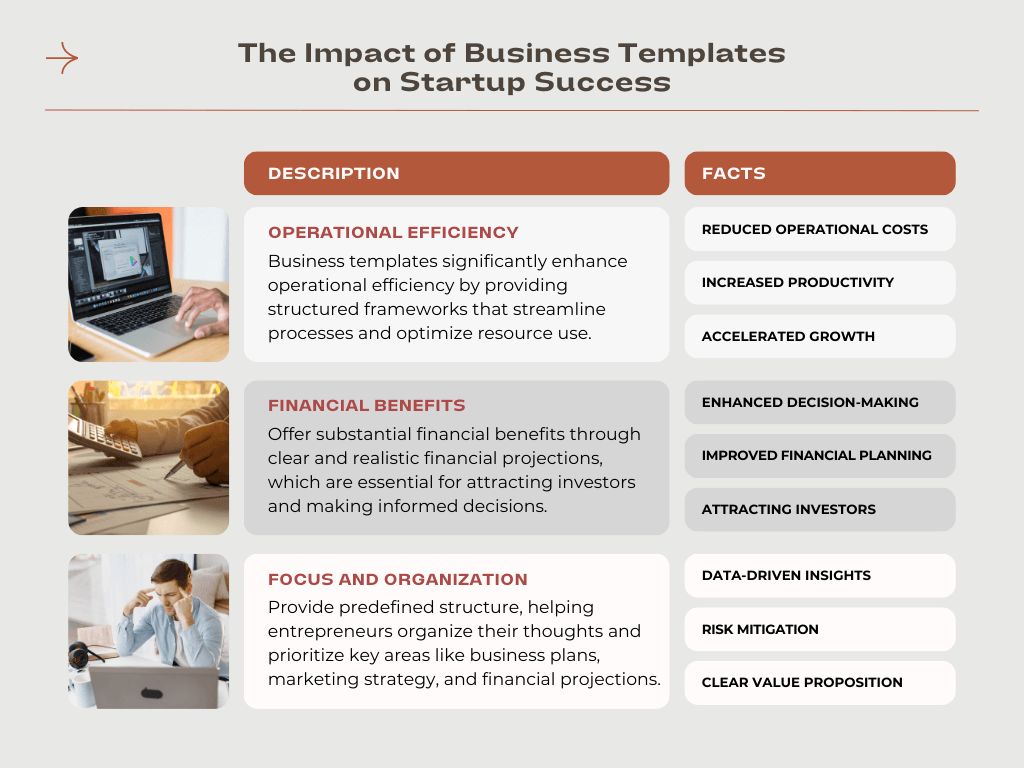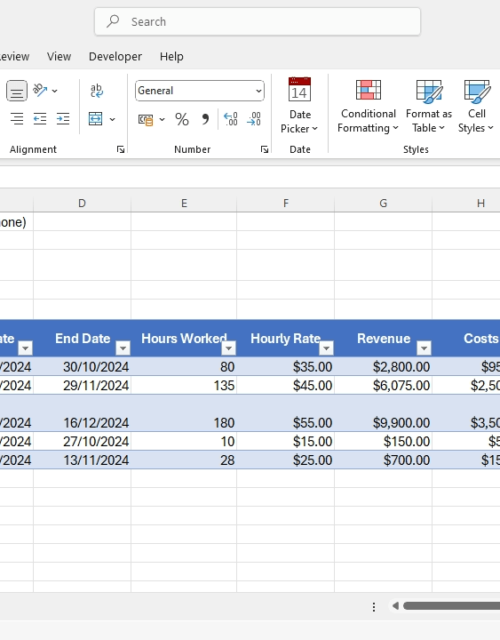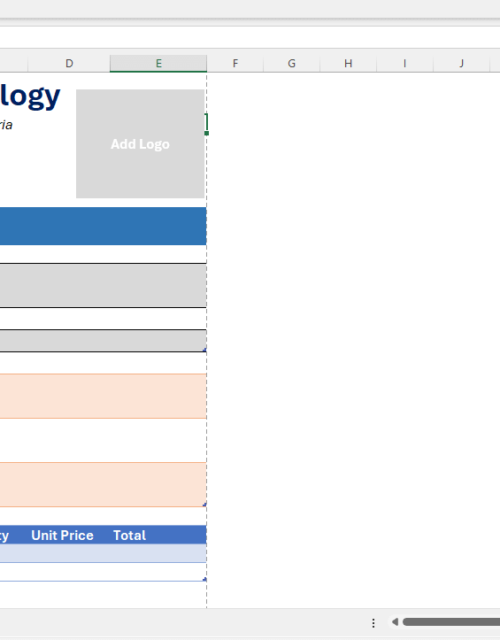How Custom Business Templates Can Accelerate Your Startup Growth

Are you planning to launch a new business, or you just started one less than 5 years ago? You are not alone. With good knowledge of custom business templates, you can grow steadily.
According to the Commerce Institute, an average of 4.7 million businesses are started annually in the US.
In 2023, over 5 million new businesses were started in the US (US Census Bureau).[1]
Moreover, 70% of these new businesses fail within the first five years. Guess what?
CBInsights identified that 19% of these startups fail due to lack of custom business templates.
In a startup ecosystem, efficiency, innovation, and scalability are paramount to success. Custom business templates are handy tools that help startups streamline operations, enhance productivity, and accelerate growth.
This guide explores how strategic implementation of business templates can drive startup success in 2025 and beyond.
Custom Business Template Revolution in Startup Growth
Let’s dive into some real-world statistics and case studies to uncover the true potential of custom business templates.
According to recent data, the success rate for startups is just under 10%. However, startups that leverage custom business templates to optimize their processes have shown a 15% higher success rate than those that don’t (Business Community, 2024).
In their study of the 30 best startups, Business Name Generator found that timing the market correctly makes a startup successful. Startups using custom templates can reduce their time to market by up to 30%, allowing them to launch products and services faster and gain a competitive edge.
Exploding topics noted that failure to have a comprehensive business template can lead to operational inefficiency. Businesses that implement custom templates can increase operational efficiency by up to 25%, leading to cost savings and improved resource allocation.
Custom Business Templates: Case studies
DietBet
This unique weight loss app turned weight loss into a competitive game. By using a custom business model for their marketing and user engagement strategies, DietBet saw a 50% increase in user retention and a significant boost in user participation.
Notion
Notion’s growth strategy focuses on community-led growth and product-led growth. They leverage their community by engaging users through ambassadors, forums, and social media. Their product is designed to be highly customizable and user-friendly, which encourages organic adoption. Notion also uses a freemium model, allowing users to start for free and upgrade for additional features.
Canva
Canva’s growth strategy revolves around its freemium business model and user-focused design. They offer a wide range of templates and tools that cater to both individuals and businesses. Canva also invests heavily in content marketing, social media engagement, and influencer marketing to attract and retain users. Their platform is designed to be intuitive and accessible, making design easy for everyone.
Airtable
Airtable’s growth strategy focuses on increasing seat numbers and raising per-seat prices. They enhance their platform’s utility across organizations and develop features to foster adoption across different departments. Airtable also uses a freemium model, offering a free plan to attract users and encourage upgrades to higher-priced tiers. Their marketing efforts include content marketing, webinars, and a strong presence on social media.
Moz
Specializing in SEO and marketing tools, Moz incorporated custom business templates to enhance their community projects. This approach led to a 35% increase in organic growth and stronger community engagement.
By leveraging custom business plans, startups can not only save time and resources but also create a solid foundation for sustainable growth.
Ready to take your startup to the next level with custom business templates? We are here for you, Contact us Now!
Understanding the Impact of Business Templates on Startup Success
Business templates have become an invaluable tool for entrepreneurs, providing a structured framework to guide the development and growth of their ventures.
It plays a crucial role in the success of startups by providing structured frameworks for planning, execution, and communication. Here are some key points backed by facts and figures:
Operational efficiency
Business templates significantly enhance operational efficiency by providing structured frameworks that streamline processes and optimize resource use. Here are some verifiable facts and figures:
- Reduced Operational Costs: Using templates, startups can reduce waste and minimize costs. For example, a study by OpenGrowth found that focusing on operational efficiency can lead to cost savings and reduced cycle time.
- Increased Productivity: Templates help in organizing tasks and workflows, leading to increased productivity. According to OpenGrowth, streamlining processes can boost employee productivity.
- Faster Turnaround Times: Optimized processes result in faster service delivery and higher quality outputs. This is crucial in today’s fast-paced market environments.
- Better Scale Management: As startups grow, business templates enable better management of scale, ensuring that processes remain efficient and effective. Good business templates can streamline processes like hiring, onboarding, and customer service, leading to increased productivity and reduced costs.
- Accelerated Growth: By providing a clear roadmap, templates can help startups achieve milestones faster and scale more effectively.
- Efficient Resource Allocation: Business templates assist in prioritizing tasks and allocating resources effectively, ensuring optimal utilization of limited funds.

Financial benefits
Business templates also offer substantial financial benefits by providing clear and realistic financial projections, which are essential for attracting investors and making informed decisions:
- Enhanced Decision-Making: Templates allow startups to make decisions based on realistic financial projections, leading to better resource allocation. A study by Baremetrics shows that it can increase the likelihood of long-term business and revenue growth.
- Attracting Investors: It is a known fact that clear and compelling financial forecasts presented through templates can attract investors. A well-structured business plan can increase the chances of securing funding.
- Improved Financial Planning: Templates provide a predefined structure for financial planning, which helps in maintaining consistency and clarity in financial communication (SmythOS).
- Increased Profit Margins: By optimizing operational efficiency and financial planning, startups can achieve higher profit margins (ClickUp, 2024). Improved efficiency can lead to an increase in profit margins.
Enhanced focus and organization
Business templates offer a predefined structure, helping entrepreneurs organize their thoughts and prioritize key areas like business plans, marketing strategy, and financial projections.
Templates save time and effort by providing a ready-made outline, allowing entrepreneurs to focus on strategic decision-making.
- Data-Driven Insights: Templates often include sections for market analysis, financial forecasting, and SWOT analysis, enabling data-driven decision-making.
- Risk Mitigation: By identifying potential risks and challenges early on, templates help entrepreneurs develop contingency plans and mitigate risks.
- Professional Presentation: Well-structured templates create a professional and polished presentation, increasing the credibility of the startup.
- Clear Value Proposition: Templates help entrepreneurs articulate their value proposition concisely and persuasively, attracting potential investors.
- Reduced Failure Rates: By identifying potential pitfalls and developing contingency plans, templates can help mitigate risks and increase the chances of long-term success.
While business templates are not a guaranteed path to success, they undoubtedly provide a solid foundation for startups. By leveraging these tools effectively, startups can streamline their processes, make informed decisions, attract investors, and ultimately drive growth and success.
Essential Customized Business Templates for Modern Startups
Custom templates are essential for streamlining processes, ensuring consistency, and enabling efficient scaling. These templates not only save time but also help in maintaining focus on strategic goals and executing plans with precision.
In this section, we will explore some of the most crucial custom templates that every modern startup should have in their toolkit, ensuring they stay ahead in the competitive landscape.
Strategic planning business templates
Strategic planning templates provide a structured framework to guide your startup’s long-term vision and goals.
These tools are designed to help organizations map out their long-term goals, objectives, and the steps needed to achieve them.
These templates provide a structured approach to strategic planning, ensuring that all aspects of the business are aligned with the overall mission and vision.
They typically include sections for market analysis, competitive intelligence, growth strategies, and more.
By leveraging these templates, you can systematically analyze your market, assess your competition, and develop effective growth strategies.
Market Analysis Framework
A market analysis framework helps businesses understand their industry, target market, and competition. It typically includes components such as market size, growth rate, trends, customer needs, and competitive landscape.
A market analysis framework helps you understand your target market’s needs, preferences, and behaviors.
A typical example is the PESTEL analysis framework which evaluates external factors (Political, Economic, Social, Technological, Environmental, Legal) that can impact a business.[2]
Key components of this framework include:
- Market Segmentation: Dividing your target market into smaller, more homogeneous groups based on demographics, psychographics, or behavior. For example, a fitness app might segment its market by age, gender, fitness goals, and preferred workout types.
- Customer Analysis: Identifying your ideal customer profile, understanding their pain points, and determining their willingness to pay. E.g., a SaaS startup might analyze its customer’s job roles, decision-making authority, and budget constraints.
- Market Sizing: Estimating the total addressable market (TAM), serviceable available market (SAM), and serviceable obtainable market (SOM). A typical food delivery startup might calculate the TAM by estimating the total food delivery market in a specific region.
Competitive Intelligence Matrix
A competitive intelligence matrix is a visual tool that compares a company’s products or services against those of its competitors based on various factors such as price, quality, features, and market share.
It allows you to assess your competitors’ strengths, weaknesses, opportunities, and threats (SWOT).
Key elements to consider include:
- Direct Competitors: Identify businesses offering similar products or services to your target market. For example, a coffee shop’s direct competitors might include other nearby coffee shops.
- Indirect Competitors: Identify businesses offering alternative solutions to the same problem. E.g., For a coffee shop, indirect competitors might include convenience stores and fast-food joints.
- Competitive Advantage: Determine your unique selling proposition (USP) and how it differentiates you from competitors. Considering other coffee shops, your coffee shop might differentiate itself by offering unique coffee blends, a cozy ambiance, or live music performances.
Growth Strategy Roadmap
A growth strategy roadmap outlines the steps a company plans to take to achieve its growth objectives. It includes timelines, milestones, and key performance indicators (KPIs) to track progress.
Key growth strategies to consider include:
- Market Penetration: Focus on increasing market share within your existing target market. E.g., a clothing brand might launch a loyalty program to encourage repeat purchases.
- Market Development: Expand into new markets or segments. For instance, a tech startup might target international markets.
- Product Development: Introduce new products or services to your existing market. Let’s take a smartphone manufacturer who released a new smartphone model with advanced features.
- Diversification: Enter new markets with new products or services. E.g., a car manufacturer might start producing electric vehicles.
Consider a five-year strategic business plan template that helps a company set and track yearly strategic goals, including operational improvements and financial strategies.
By utilizing these strategic planning templates, you can gain a competitive edge and position your startup for long-term success.

Operational business templates
Operational templates are essential for ensuring smooth day-to-day operations and maintaining consistency across various business processes. They help streamline workflows, manage resources, and improve overall efficiency.
Here are some key operational templates that every startup should consider:
Business Startup Checklist Template Components
A Business Startup Checklist is an essential tool for ensuring that all crucial steps are covered when launching a new venture. Here are the key components you need to include in your checklist:
1. Legal Requirements Tracker
Starting a business involves navigating a myriad of legal requirements. A Legal Requirements Tracker helps you keep track of necessary registrations, licenses, and permits.
It is a vital tool for startups to ensure compliance with local, state, and federal regulations.
It ensures that you comply with all legal obligations and avoid potential fines or legal issues.
Key Components:
- Business Registration: Document the registration of your business name and legal structure (e.g., LLC, Corporation).
- Licenses and Permits: Track industry-specific licenses and local permits required to operate legally.
- Tax Identification Numbers: Ensure you obtain relevant TINs (e.g., EIN in the US, TIN in Nigeria).
- Insurance Policies: Record necessary insurance coverage (e.g., liability, workers’ compensation, etc).
2. Resource Allocation Matrix
A resource allocation matrix helps you allocate your limited resources effectively to achieve your business goals. It provides a clear overview of your resources, their utilization, and potential bottlenecks.
Efficient resource allocation is critical for the success of any startup. A Resource Allocation Matrix helps you plan and assign resources, such as personnel, equipment, and budget, to various tasks and projects.
Key Components:
- Resource Inventory: A list of all available resources, including human resources, financial resources, and physical assets.
- Resource Allocation: A breakdown of how resources are allocated to different projects or tasks.
- Task Assignments: List out tasks and the team members responsible for each.
- Budget Allocation: Allocate budget to different projects or departments to ensure financial control.
- Timeline: Link tasks to specific timelines to manage deadlines effectively.
3. Timeline Management System
A Timeline Management System is essential for tracking the progress of your startup’s milestones and deadlines. It ensures that your team stays on schedule and that critical tasks are completed on time.
Key Components:
- Project Timeline: A visual representation of the project timeline, including milestones and deadlines.
- Task Breakdown Structure: A hierarchical breakdown of project tasks and subtasks.
- Task Dependencies: Identify dependencies between tasks to manage workflow efficiently.
- Gantt Chart: Visualize project timelines and dependencies using a Gantt chart.
- Progress Tracking: Monitor the progress of tasks and adjust timelines as necessary.
4. Compliance Verification Checklist
Compliance with industry regulations and standards is crucial for any business. A compliance verification checklist helps you ensure that your business adheres to all relevant regulations and industry standards.
It helps you identify potential compliance gaps and take corrective action.
Key Components:
- Regulatory Requirements: List specific regulations your business must comply with (e.g., GDPR, HIPAA, etc).
- Verification Procedures: Detailed procedures for verifying compliance with each requirement.
- Internal Policies: Document internal policies that ensure compliance (e.g., data privacy, security protocols).
- Audit Schedule: Plan regular audits to verify ongoing compliance.
- Corrective Actions: Track and implement corrective actions for any identified compliance issues.
Standard Operating Procedure (SOP) Template
SOP templates document the step-by-step processes for routine operations. They ensure that tasks are performed consistently and correctly every time, reduce training time, and minimize errors.
For example, an SOP for Onboarding New Employees template outlines the necessary steps and requirements for integrating new hires into the company smoothly.
Project Management Template
A project management template helps in planning, executing, and monitoring projects. It includes sections for defining project scope, timelines, milestones, tasks, and responsibilities.
For example, the Gantt Chart template, which provides a visual timeline for project activities, helping teams stay on track and meet deadlines.
By integrating these components into your Business Startup Checklist, you can streamline your operations, ensure legal and regulatory compliance, and manage resources effectively.
Customized financial templates
Financial templates are critical tools for managing the financial health of a startup. They help track expenses, manage cash flow, forecast revenues, and ensure financial stability.
Here are some key financial templates that every startup should have:
Budget Template
A budget template helps startups plan their finances by estimating income and expenses over a specific period. It ensures that the business stays within its financial limits and allocates resources effectively.
Components:
- Income Projections: Estimate your expected income from various sources.
- Expense Categories: List all expenses, including fixed (rent, salaries) and variable (utilities, marketing).
- Net Income: Calculate the difference between total income and total expenses.
- Monthly Breakdown: Provide a month-by-month breakdown for detailed tracking.
Use budget templates to allocate resources effectively, control costs, and achieve financial goals.
Cash Flow Statement
A cash flow statement tracks the movement of cash in and out of the business. It helps startups monitor liquidity and ensure they have enough cash to meet their obligations.
Components:
- Operating Activities: Cash generated or used in the core business operations.
- Investing Activities: Cash used for investments in assets like equipment or property.
- Financing Activities: Cash flows from financing activities like loans or equity funding.
- Net Cash Flow: The net change in cash position over a specific period.
Use cash flow templates to manage cash flow, identify potential cash shortages, and plan for future investments.
Profit and Loss Statement (P&L)
The P&L statement provides a summary of the revenues, costs, and expenses incurred during a specific period. It shows the company’s ability to generate profit.
Components:
- Revenue: Total income earned from sales or services.
- Cost of Goods Sold (COGS): Direct costs of producing goods or services sold.
- Gross Profit: Revenue minus COGS.
- Operating Expenses: Indirect costs like rent, utilities, and salaries.
- Net Profit: Gross profit minus operating expenses.
Use the P & L statement to analyze profitability, identify cost-cutting opportunities, and make informed business decisions.
Balance Sheet
A balance sheet provides a snapshot of the company’s financial position at a specific point in time. It includes assets, liabilities, and shareholders’ equity.
Components:
- Assets: Resources owned by the company (e.g., cash, inventory, property).
- Liabilities: Obligations the company owes to others (e.g., loans, accounts payable).
- Equity: The owner’s claim on the company’s assets after liabilities are deducted.
- Assets = Liabilities + Equity: This fundamental equation ensures the balance sheet is balanced.
Break-Even Analysis
A break-even analysis helps determine the sales volume needed to cover all costs, both fixed and variable. It identifies the point at which the business will start generating profit.
Components:
- Fixed Costs: Costs that remain constant regardless of production volume.
- Variable Costs: Costs that vary with production volume.
- Sales Revenue: Income generated from sales.
- Break-Even Point: The sales volume at which total revenue equals total costs.
Used to monitor the sales or production volume a company need to stay in business.
Expense Report Template
Expense report tracks business expenses.
Components:
- Date: Tracks the day expense is recorded
- Expense Category: Differentiates classes of expenses e.g. utility, marketing, etc
- Amount: Capture the exact amount expended.
- Description: Details the type of expenses.
Use expense report to Reimburse employees, analyze spending patterns, and identify cost-saving opportunities.
Revenue Projection Models
Revenue projection models help startups forecast future revenues based on various assumptions and scenarios. Accurate revenue projections are essential for planning and securing funding.
Components:
- Historical Data: Use past sales data to identify trends and patterns.
- Market Analysis: Evaluate market conditions, customer demand, and competitive landscape.
- Growth Assumptions: Make assumptions about growth rates, market expansion, and new product launches.
- Scenario Analysis: Create different scenarios (optimistic, pessimistic, and realistic) to understand potential revenue outcomes.
- Visualization: Use charts and graphs to visualize revenue projections over time.
Use revenue models to forecast future sales and the future financial health of the company.
Custom Business Templates: Implementation Strategies for Maximum Growth
Maximizing growth involves strategic planning and seamless execution. Start with a clear vision and goals that align with your core values and market demands.
Conduct thorough market research to identify opportunities and potential challenges. Focus on building a strong, adaptable business model and investing in scalable systems and technologies.
Cultivate a high-performance culture by empowering and motivating your team. Foster innovation and continuously improve your products or services to stay ahead of the competition.
Collaborate with strategic partners and leverage their strengths to create synergies. Measure progress through key performance indicators and be agile enough to pivot when necessary.
Template selection process
Consider these factors when choosing custom business templates for startups:
- Scalability potential: Ensure the template can grow with your business needs.
- Integration capabilities: Verify the template seamlessly integrates with your existing systems.
- Customization options: Look for flexibility to modify templates to suit your unique requirements.
- User-friendly interface: Prioritize ease of use to enhance productivity and reduce learning curves.
- Data security features: Protect sensitive information with robust security measures in the template.
Integration best practices
Follow this proven implementation framework:
- Audit existing processes: Assess current workflows to identify inefficiencies.
- Identify automation opportunities: Spot areas where automation can streamline operations.
- Customize templates to specific needs: Tailor solutions to meet unique business requirements.
- Train team members: Equip your staff with the skills needed to leverage new systems effectively.
- Monitor and optimize: Continuously track performance and make improvements for maximum efficiency.
Conclusion
Custom business templates have become indispensable tools for startup growth and success.
By implementing the right templates and following best practices, startups can significantly accelerate their growth while maintaining operational excellence and financial stability.
Studies have shown that custom business templates are not just tools but strategic assets for startup growth.
Companies like Notion, Canva, and Airtable demonstrate that template-driven approaches can lead to exponential growth and operational excellence.
[1] https://www.commerceinstitute.com/new-businesses-started-every-year/








